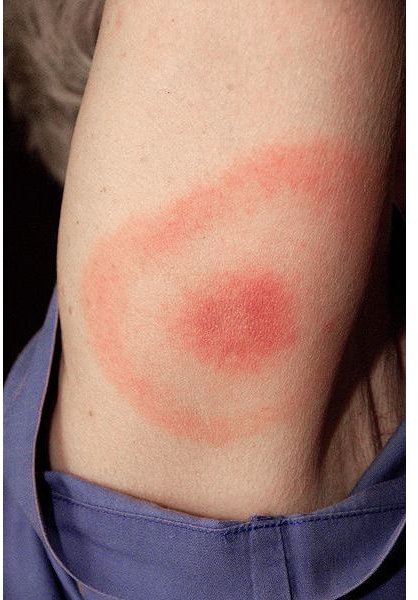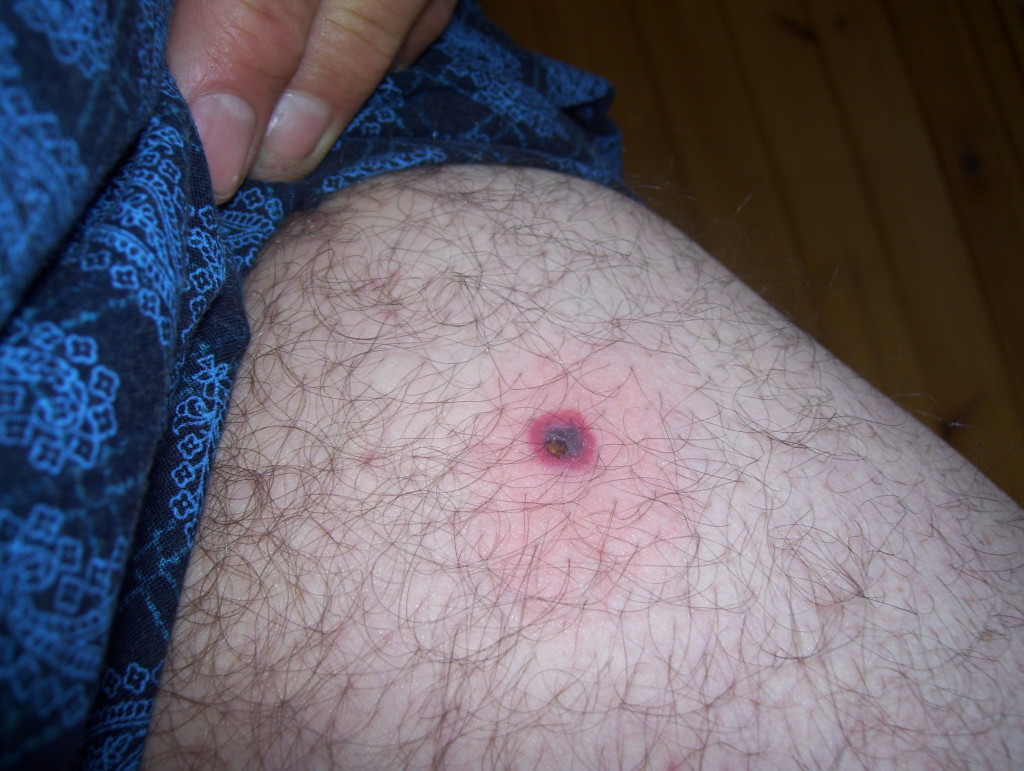

Nerve inflammation causes pain, numbness, and tingling in the arms or legs.Meningitis causes headache, fever, and stiff neck.(Bell's palsy) is paralysis of the facial nerve that causes the facial muscles to be unevenĪnd droop. The organs affected later in the course of the disease may lead to the following conditions and complications: Left untreated, signs and symptoms of the primary illness usually will go away on their own within a few weeks, although the rash may recur.ĭays to months later, additional symptoms of Lyme disease may occur.
TICK BULLSEYE SKIN
Symptoms and signs in children are similar, though younger children are more likely to have skin lesions occur on the head or neck and older children on the extremities. In a minority, it may take on the appearance of a target with multiple rings (alternating red with clear skin), called a bull's-eye lesion.


This growth in size of the red spots on the skin is characteristic of Lyme disease.Īs it grows, the rash can remain red throughout, although it often can develop a clear central area. All of these lesions can enlarge to the size of a football. Multiple secondary lesions can occur that are a reaction to the infection and are not due to multiple tick bites. When the rash occurs at the site of the tick bite, it is called a primary lesion. A red circular spot that begins within hours and is smaller is usually a reaction to the tick bite. Centers for Disease Control and Prevention (CDC) defines this rash as a skin lesion that typically begins as a red spot and expands over a period of days to weeks to form a large round lesion, at least 5 cm (about 2 inches) across, and up to 30 cm (12 inches). It is called erythema migrans and occurs in about 70%-80% of infected individuals. The rash is a red rash that grows in size daily. The flu-like illness usually occurs in the warm weather months when flu ( influenza) does not occur. This rash may feel warm to the touch but is rarely itchy or painful. But many people experience a flu-like primary illness or a characteristic rash several days to a few weeks following a tick bite. The initial infection can occur with minimal or no signs or symptoms. General feeling of being unwell (malaise).SLIDESHOW What Is Rheumatoid Arthritis (RA)? Symptoms, Treatment, Diagnosis See SlideshowĮarly signs and symptoms of Lyme disease occur from three to 30 days after a tick bite and include Pets who are not protected against ticks may bring them indoors.Having bare, unprotected skin when outdoors in high-risk areas.Fishing, camping, hunting, yard work, hiking, and other outdoor activities in tick-infested areas.Being outdoors in the woods or areas that have tall grass, shrubs, or brush.states where the disease is most prevalent Living in the northeastern or Midwestern U.S.Risk factors for getting Lyme disease include the following: Talk to a veterinarian about the right type of tick control for any pets. However, dogs and cats can bring the infected ticks into the home, which is one reason why tick protection for pets is important. While dogs and cats can get Lyme disease, there are no reported cases of these animals spreading the disease to their owners. Lyme disease is not contagious and cannot be passed from person to person. Humans are not a part of the bacterium's life cycle but can become infected when bitten by the tick. The bacteria have a complex life cycle, spending part of their life in the deer tick and part in some mammals such as mice and deer. What Are Lyme Disease Causes and Risk Factors?ī.

in 1977, after an unexpected number of residents in Lyme, Conn., were found to have a "new" and unusual illness. Doctors at New Haven's Yale Medical Center first described and named Lyme disease in the U.S.It is most prevalent in the northeastern and Midwestern states of the U.S., with about 96% of reported cases occurring in 14 states, including Connecticut, Delaware, Maine, Maryland, Massachusetts, Minnesota, New Hampshire, New Jersey, New York, Pennsylvania, Rhode Island, Vermont, Virginia, and Wisconsin.The disease has been reported in the Northeast, Mid-Atlantic, North Central, and Pacific coastal regions of the United States (see map) and in Europe, where it was first described almost 100 years ago.Lyme disease, sometimes referred to as Lyme infection or borreliosis, is a bacterial illness, transmitted to humans by the bite of deer ticks ( Ixodes ticks) carrying a bacterium known as Borrelia burgdorferi. Picture of Lyme Disease Including a Red Bull's-Eye Rash


 0 kommentar(er)
0 kommentar(er)
